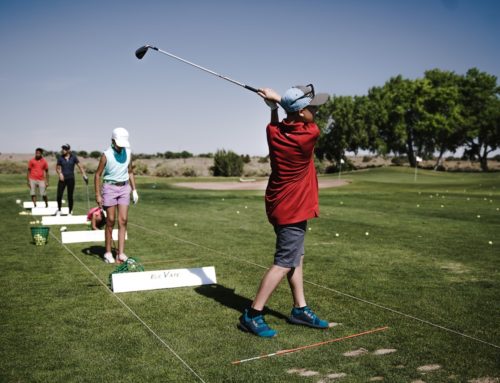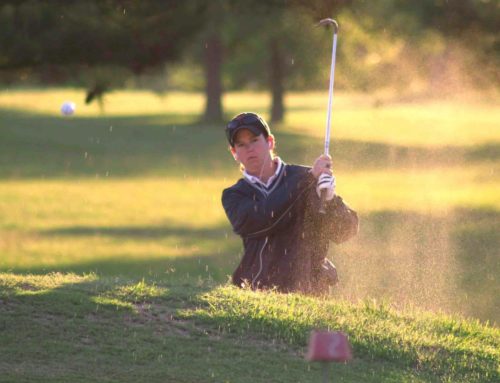Many factors can influence how a shot pans out. How you position and move your body, the club, and the ball relative to each other affects consistency and accuracy when golfing.
The critical thing to remember is that golf is a game of constant learning because there are so many situations you can find yourself in, requiring you to come up with creative ways to navigate them. Below are some useful tips and tricks that may help improve your game and make you stand out.
The grip
Your grip will determine the contact of the club with the golf ball. You’ll find many tips on the interlocking, overlapping, or ten-finger grip when golfing. It doesn’t matter which one you use, just make sure that the club rests on the heel of your trailing hand’s palm, and your fingers do most of the gripping.
There should be no space between both of your hands, and your trailing thumb should go along the length of the club such that the leading hand is on top of it, making it disappear.
Ball position
You can place the golf ball relative to your stance when teeing up. It doesn’t always have to be in line with your club. This will help you get shot variation in golf because of the club’s loft, which can help when using fairways to get on the green.
Additionally, you can use the line or markers on the golf ball relative to the flag and position it accordingly on the grass. This way, you don’t have to keep looking at the flag for your target, improving accuracy and aim while golfing.
Reverse K
After you’ve had a firm grip on your club, an excellent way to get in teeing position is by bringing your club parallel to the ground with your arms straight. Stand with your back and legs straight and bend forwards with the hip joint while keeping your back and legs straight. Relax and bend your knees very slightly to get into a comfortable position.
These tips will help you get into the reverse K position with your hips pointing towards the hole. This keeps your lead side straight, and your spine angled slightly away from the hole. The reverse K is a good position to start your backswing as it prevents your hips from pushing away from when you swing your club upwards.
Backswing
When in the reverse K position, don’t keep your spine crooked, as this is a lousy position to turn from when initiating your backswing. Keeping your back straight lets you rotate your body and turn around the spine to get the required power from your core rather than just your arms, putting you in an excellent position at the end of the backswing.
Slicing
Golfers make a common mistake while golfing – they drag the club away from the ideal swing path when bringing it upwards during the backswing. Because of this, they have to correct it by opening the clubface on the downswing, causing the golf ball to go away from the intended line.
Imagining a plane running along the length of the club is one of the best tricks to fix this. When you swing, make sure the club slices within this plane. Additionally, when you take your club upwards during your backswing, you’ll see that the clubface mirrors the angle of your back when horizontal. This can be a good reference point to see if your club remains within the plane.
Forward Press
One of the best tricks to getting your chipping shots right is to forward press your arms and wrists such that the golf club is no longer in line with your body. Make sure the clubface remains perpendicular to the ground. You’ll notice that this is a more exaggerated reverse k when taking the shot but make sure your body stays this way on the descending blow. From there on, all you’ll have to practice is getting the distance right.
Wind
Windy conditions can make it tough for you to implement any tips and tricks up your sleeve because the speed and direction of the wind can immensely change the golf ball’s trajectory. In this case, it’s best to look at the flag. The direction in which it flutters tells you the direction of the wind, and the rate at which it flutters can give you an idea of its speed. Adjust for both before your stance and swing so that when you drive the golf ball, the wind corrects it.
Sand
Don’t you hate it when the golf ball gets trapped in a bunker? When taking bunker shots, a good tip is to hold out your club perpendicular to the ground. Grip your club such that it turns and becomes slightly open. This causes the club’s edge to turn, making the club bounce in the sand instead of digging deeper, making good contact with the ball and out of the bunker.
Aim higher
It is more likely to sink a putt on the green when the ball is closer to the hole because it is easier to judge the line for the ball to follow.
So if you’re putting from afar, make sure to pick a reference point further away from the hole. Why? Let’s say you took the putt using the flag as a marker. The ball stayed on the line but was still 6 feet away. It may take another two shots for you to get the hole. If you aim for a point further from the hole, the chances are that it may overshoot by just a bit, and you can get the hole in one more shot.
Film your swing
Recording yourself while you swing can be great if you’re looking for feedback on your shots. You can take snapshots of your golfing stance in your videos and make lines with a drawing tool to see if you make the correct reverse K, how you turn for the backswing, or if the golf ball hits the sweet spot on your club during contact.
Composure is Key
Most people forget that golfing is a mind game as well, and a lot of times, a bad shot can make you nervous and make you lose your composure causing all your tricks to fail.
The best way to go about his is to keep your thoughts at bay by adopting a healthy self-talk habit where you outline your options after a bad shot. This will significantly improve your game by making you your own caddy as you know yourself better than anyone, helping you devise strategies quicker when faced with tricky situations. Plus, it shows excellent sportsmanship and may even intimidate your opponents.
Practice
Practice will make all the difference when it comes to learning new tips and tricks to golfing or any sport, for that matter. Try swinging with different woods and fairways. See if your swing changes with each and take mental notes about what you need to correct and how the ball travels with each of them.
Try incorporating drills like placing golf balls one foot apart in a line and putting or chipping them. This will help improve your judgment and aim when golfing close to the green.







Leave A Comment